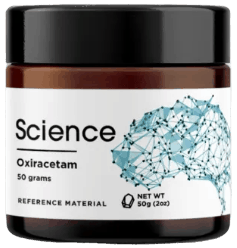
Piracetam and oxiracetam are two popular racetam nootropics that have gained significant attention for their cognitive-enhancing properties.
While both compounds share similarities in their chemical structure and mechanisms of action, they also exhibit distinct differences that can influence their effects on the brain and overall user experience.
In this article, we will delve into the key features, benefits, drawbacks, and user experiences of piracetam and oxiracetam to help you make an informed decision when choosing between these two nootropics for cognitive enhancement.
Table of Contents
What Are the Key Features of Piracetam and Oxiracetam?
Piracetam and oxiracetam are both synthetic compounds belonging to the racetam family of nootropics.
Piracetam, the original racetam, was first synthesized in 1964 and has been extensively researched for its cognitive-enhancing properties. Oxiracetam, a more potent derivative of piracetam, was developed later to offer enhanced bioavailability and effectiveness.
What Is Piracetam and What Are Its Ingredients?

Piracetam (C6H10N202) is a synthetic nootropic compound and the original member of the racetam family. Piracetam is a cyclic derivative of GABA (gamma-Aminobutyric acid) and is composed of a 2-oxo-pyrrolidine ring with an acetamide group attached to the first carbon atom.
It was first synthesized in 1964 by Belgian chemist Corneliu E. Giurgea, who coined the term “nootropic” to describe its cognitive-enhancing properties.
What Is Oxiracetam and What Are Its Ingredients?

Oxiracetam (C6H10N203) is a racetam nootropic and a derivative of piracetam, differing by the addition of a hydroxyl group at the 4-position of the 2-pyrrolidinone ring. It was first synthesized in the 1970s as a more potent and bioavailable alternative to piracetam.
Oxiracetam shares the same core structure as piracetam but exhibits distinct pharmacological properties due to its structural modifications.
How Do the Ingredients in Piracetam and Oxiracetam Compare?
While piracetam and oxiracetam share a similar core structure, the addition of a hydroxyl group in oxiracetam leads to several key differences:
- Potency: Oxiracetam is considered to be 3-5 times more potent than piracetam, requiring lower doses to achieve similar cognitive-enhancing effects.
- Bioavailability: The hydroxyl group in oxiracetam increases its fat solubility, resulting in better absorption and bioavailability compared to piracetam.
- Onset and duration: Oxiracetam tends to have a faster onset of action and a shorter half-life compared to piracetam, leading to quicker effects but requiring more frequent dosing.
Piracetam vs Oxiracetam Dosage
The recommended dosages for piracetam and oxiracetam differ due to their varying potencies and bioavailabilities.
Piracetam:
- Standard dose: 1,600-4,800 mg per day, divided into 2-3 doses
- Some users may require up to 9,600 mg per day for optimal effects
Oxiracetam:
- Standard dose: 800-1,200 mg per day, divided into 2-3 doses
- Higher doses of up to 2,400 mg per day may be used in some cases
It’s important to start with lower doses and gradually increase as needed to assess individual tolerance and response.
How Do Piracetam and Oxiracetam Work for Cognitive Enhancement?
Piracetam and oxiracetam work by modulating various neurotransmitter systems in the brain, primarily the cholinergic and glutamatergic systems. These mechanisms contribute to the cognitive-enhancing effects of piracetam and oxiracetam, such as improved memory, learning, focus, and mental clarity.
What Are the Cognitive Benefits of Using Piracetam?
Piracetam has been extensively studied for its cognitive-enhancing properties, with research suggesting that it may:
- Improve memory and learning: Piracetam has been shown to enhance various aspects of memory, including working memory, verbal learning, and long-term memory consolidation.(1)
- Enhance focus and attention: Studies indicate that piracetam can improve attention span, concentration, and mental clarity, particularly in individuals with cognitive impairments.(2)
- Increase cerebral blood flow: Piracetam has been found to increase blood flow and oxygen delivery to the brain, supporting optimal cognitive function.(3)
What Are the Cognitive Benefits of Using Oxiracetam?
Oxiracetam has been investigated for its nootropic effects, with research indicating that it may:
- Enhance memory and learning: Oxiracetam has been shown to improve various aspects of memory, including spatial learning, memory consolidation, and recall.(4)
- Boost attention and focus: Studies suggest that oxiracetam can improve attention, concentration, and mental alertness, particularly in individuals with cognitive deficits.(5)
- Promote neuroprotection: Oxiracetam has demonstrated neuroprotective properties, potentially reducing cognitive decline and supporting brain health.(6)
How Do Piracetam and Oxiracetam Differ in Their Mechanisms of Action?
While piracetam and oxiracetam share some similarities in their mechanisms of action, there are notable differences:
- Cholinergic system: Both piracetam and oxiracetam are believed to enhance cholinergic neurotransmission, but oxiracetam has been shown to have a more potent effect on acetylcholine release and uptake.
- Glutamatergic system: Oxiracetam has been found to modulate glutamate receptors, particularly AMPA receptors, more potent than piracetam, contributing to its cognitive-enhancing effects.
- Neuronal excitability: Oxiracetam has been shown to increase neuronal excitability and synaptic plasticity more effectively than piracetam, potentially leading to more pronounced cognitive benefits.
What Are the Pros and Cons of Piracetam and Oxiracetam?
Piracetam and oxiracetam offer several cognitive benefits but also come with some potential drawbacks.
Pros:
- Enhance memory, learning, and recall
- Improve focus, attention, and concentration
- Boost mental clarity and reduce brain fog
- Increase verbal fluency and creativity
- Neuroprotective and anti-aging properties
Cons:
- May cause headaches without sufficient choline intake
- Oxiracetam can be stimulating and may disrupt sleep if taken late in the day
- Individual response varies; some users may not experience significant benefits
- Long-term safety data is limited, especially for high doses
What Are the Advantages and Limitations of Piracetam?
Advantages of piracetam are following:
- Well-researched and established safety profile
- Minimal side effects and drug interactions
- Effective for a wide range of cognitive impairments
- Lower cost compared to other racetams
Limitations of piracetam include:
- Requires higher doses for optimal effects
- May take longer to produce noticeable cognitive benefits
- Some users may not respond well to piracetam
What Are the Advantages and Limitations of Oxiracetam?
There are several advantages of oxiracetam:
- Higher potency and faster onset of action compared to piracetam
- Better bioavailability and penetration of the blood-brain barrier
- More targeted cognitive effects, particularly on memory and learning
- Lower effective dose range
Limitations of oxiracetam may include the following:
- Less extensive research compared to piracetam
- Higher cost compared to piracetam
- Potential for more pronounced side effects in some users
How Do Users Experience Piracetam and Oxiracetam?
User experiences with piracetam and oxiracetam vary, but many report positive effects on cognitive function.
What Are Common User Experiences and Testimonials for Piracetam?
User experiences with piracetam vary, but common reported benefits include:
- Improved memory and recall
- Enhanced verbal fluency and communication skills
- Increased mental clarity and focus
- Better overall cognitive performance
Some users also report improved mood and reduced mental fatigue.
“I’ve been using piracetam daily for 3 months, and it’s significantly improved my memory recall and mental clarity. I feel sharper and more articulate in conversations and writing.” – John D., 35, software engineer
“Piracetam has been a game-changer for my studying. I retain information better and can focus for longer periods without getting distracted.” – Sarah K., 22, university student
What Are Common User Experiences and Testimonials for Oxiracetam?
User experiences with oxiracetam often highlight its more targeted cognitive effects, such as:
- Significant improvements in memory consolidation and recall
- Enhanced spatial learning and navigation skills
- Increased mental energy and alertness
- Better sensory perception and processing
Many users also report faster onset of effects and more noticeable cognitive benefits compared to piracetam.
“Oxiracetam gives me a smooth, stimulant-like boost in energy and motivation without the jitters or crash. It’s helped me power through tough projects at work.” – Michael R., 41, marketing manager
“I find oxiracetam more potent than piracetam for enhancing mental speed and verbal fluency. It’s my go-to nootropic for important meetings and presentations.” – Lisa S., 29, business consultant
How Do Individual Responses to Piracetam and Oxiracetam Vary?
Individual responses to piracetam and oxiracetam can vary significantly due to factors such as:
- Genetics and neurochemistry
- Age and cognitive status
- Dosage and duration of use
- Concurrent use of other nootropics or medications
Some users may experience more pronounced benefits from one racetam over the other, while others may not respond well to either.
What Are the Side Effects and Safety Profiles of Piracetam and Oxiracetam?
Piracetam and oxiracetam are generally well-tolerated and considered safe at recommended doses. However, some users may experience side effects:
- Headaches (often due to insufficient choline intake)
- Insomnia or disturbed sleep (more common with oxiracetam)
- Gastrointestinal discomfort, nausea, or diarrhea
- Anxiety or irritability (rare)
According to a systematic review by Malykh and Sadaie (2010), piracetam has a favorable safety profile with few adverse effects reported in clinical trials. Oxiracetam also appears to be well-tolerated, but fewer long-term studies have been conducted.
What Side Effects Have Been Reported with Piracetam?
Piracetam is generally well-tolerated, with minimal reported side effects. The most common side effects include:
- Headaches
- Anxiety
- Insomnia
- Gastrointestinal discomfort
What Side Effects Have Been Reported with Oxiracetam?
Oxiracetam, being more potent than piracetam, may have a slightly higher incidence of side effects. Common reported side effects include:
- Headaches
- Nervousness or agitation
- Insomnia
- Nausea or stomach discomfort
How Do the Safety Profiles of Piracetam and Oxiracetam Compare?
Both piracetam and oxiracetam have favorable safety profiles, with no serious adverse effects reported in clinical studies or long-term user experiences. However, given oxiracetam’s higher potency, it may have a slightly higher potential for side effects in some individuals.
It’s important to consult with a healthcare professional before starting any nootropic regimen, particularly if you have pre-existing medical conditions or are taking medications.
In What Situations Should You Choose Piracetam and Oxiracetam and Vice Versa?
Piracetam is a good choice for those new to racetam nootropics due to its well-established safety profile and milder effects that make it suitable for people aged 40+.
Oxiracetam is more suitable for those seeking a stronger cognitive boost for demanding mental tasks, such as complex problem-solving, creative work, or high-pressure situations. However, its stimulant-like effects may be too strong for some users.
When Is Piracetam the Preferred Choice?
Piracetam may be the preferred choice in situations such as:
- Individuals new to nootropics and racetams
- Those seeking a well-researched and established nootropic
- Individuals with a history of sensitivity to more potent nootropics
- Those on a tighter budget
When Is Oxiracetam the Preferred Choice?
Oxiracetam may be the preferred choice in situations such as:
- Individuals seeking more targeted cognitive effects, particularly on memory and learning
- Those who have not responded well to piracetam in the past
- Individuals looking for a faster onset of action and more noticeable cognitive benefits
- Those willing to invest in a more potent nootropic option
How Do Piracetam and Oxiracetam Compare in Terms of Cost and Value?
While oxiracetam is more expensive, many users find it provides better value due to its higher potency and effectiveness. A typical daily dose of oxiracetam (800-1,200 mg) is lower than that of piracetam (2,400-4,800 mg), making it more cost-effective on a per-dose basis.
What Are the Price Points of Piracetam and Oxiracetam?
Piracetam is generally less expensive than oxiracetam, with prices ranging from $0.50 to $1.50 per gram, depending on the supplier and quantity purchased.
Oxiracetam, being more potent and less widely available, typically costs between $1.50 and $3.00 per gram.
How Do the Costs of Piracetam and Oxiracetam Compare in Terms of Value for Money?
Given oxiracetam’s lower effective dose range and more targeted cognitive effects, it may provide better value for some users despite the higher cost per gram.
Piracetam, on the other hand, offers a more affordable option for those seeking a well-established and versatile nootropic, particularly when purchased in larger quantities.
How to Choose Between Piracetam and Oxiracetam Based on Personal Needs?
When choosing between piracetam and oxiracetam, consider your individual goals, sensitivity to nootropics, and tolerance for stimulant-like effects.
What Factors Should Be Considered When Choosing Between Piracetam or Oxiracetam?
When deciding between piracetam and oxiracetam, consider the following factors:
- Specific cognitive goals and desired effects
- Previous experience with nootropics and racetams
- Individual sensitivity to nootropics and potential for side effects
- Budget and cost-effectiveness
- Willingness to experiment with dosages and stacking options
How Can You Determine Which Nootropic Is Right for Your Specific Needs?
To determine which nootropic best suits your needs, follow these steps:
- Clearly define your cognitive goals and desired outcomes.
- Research the specific effects and mechanisms of action of each racetam.
- Start with a lower dose of your chosen racetam and assess your individual response.
- Adjust dosage and stacking options as needed based on effects and tolerability.
- Keep a log of your experiences and consult with a healthcare professional if needed.
Remember that individual responses to nootropics can vary significantly, so it may take some experimentation to find the optimal racetam and dosage for your specific needs.
Where to Buy Piracetam or Oxiracetam?
Science.bio is a reputable source for purchasing piracetam and oxiracetam. They offer high-quality, lab-tested nootropics at competitive prices.
Science.bio ensures purity and potency, providing peace of mind for nootropics enthusiasts seeking cognitive enhancement.
What Are the Long-Term Effects and Benefits of Using Piracetam and Oxiracetam?
Long-term use of piracetam and oxiracetam may offer neuroprotective and anti-aging benefits, potentially slowing cognitive decline and improving brain health.
Additional potential long-term benefits from both are included in the following sub-sections.
What Long-Term Cognitive Benefits Can Be Expected from Piracetam?
Long-term use of piracetam has been associated with sustained cognitive benefits, such as:
- Improved memory and learning capacity
- Enhanced verbal fluency and communication skills
- Better overall cognitive performance and mental clarity
- Potential neuroprotective effects and reduced cognitive decline
These long-term benefits are particularly evident in individuals with cognitive impairments or age-related cognitive decline.
What Long-Term Cognitive Benefits Can Be Expected from Oxiracetam?
Long-term use of oxiracetam may offer similar sustained cognitive benefits, with some unique advantages:
- Significant improvements in memory consolidation and recall over time
- Enhanced spatial learning and navigation skills
- Increased mental energy and alertness
- Potential neuroprotective effects and reduced cognitive decline
Given oxiracetam’s more targeted effects on memory and learning, long-term use may be particularly beneficial for individuals seeking to optimize these cognitive domains.
How Can You Optimize the Use of Piracetam and Oxiracetam for Maximum Benefit?
To optimize the cognitive-enhancing effects of piracetam and oxiracetam, consider the following tips:
- Start with a low dose and gradually increase as needed to find your optimal dosage.
- Take with a choline source (e.g., alpha-GPC, citicoline) to prevent headaches and enhance acetylcholine levels.
- Cycle your use, taking breaks of 1-2 weeks every 1-2 months to maintain sensitivity and avoid tolerance.
- Stack with complementary nootropics like L-theanine, bacopa monnieri, or omega-3 fatty acids for synergistic effects.
- Maintain a healthy lifestyle with regular exercise, good sleep, and a balanced diet to support brain health.
Read on to learn more about how to optimize your usage of these two smart drugs.
What Are the Best Practices for Using Piracetam?
Start with a lower dose of 1,600 mg and slowly increase to the target amount over a few weeks.
Key tips for using piracetam:
- Dosage: 1,200 – 4,800 mg/day, split into 3 doses
- Stack with a choline source (300-600 mg/day)
- Cycle usage: 2-3 months on, 1 month off
- Start low and gradually increase dosage
What Are the Best Practices for Using Oxiracetam?
Since oxiracetam is fat-soluble, taking it with a meal containing healthy fats can improve absorption. Doses are typically taken in the morning and early afternoon to avoid impacting sleep. Slowly titrate up the dose, starting around 450 mg/day.
Tips for optimal oxiracetam use:
- Dosage range: 750 – 1,500 mg per day, split into 2-3 doses
- Combine with choline (alpha-GPC or citicoline)
- Cycle: 1-2 months on, 1-2 weeks off
- Take with food containing healthy fats
- Avoid dosing in late afternoon/evening
- Start low (450 mg) and increase slowly
Which Nootropic Supplement Is Better: Piracetam or Oxiracetam?
Both racetams offer cognitive-enhancing effects, but oxiracetam may be more suitable for those seeking targeted improvements in memory and learning, while piracetam provides a more versatile and well-established option.
It may take some experimentation with different dosages and stacking options to find the optimal racetam for your needs.
Remember to start with lower doses, monitor your individual response, and consult with a healthcare professional if needed.
- Loscertales, M et al. “Piracetam facilitates long-term memory for a passive avoidance task in chicks through a mechanism that requires a brain corticosteroid action.” The European journal of neuroscience vol. 10,7 (1998): 2238-43. doi:10.1046/j.1460-9568.1998.00234.x↩
- Wilsher, C R. “A brief review of studies of piracetam in dyslexia.” Journal of psychopharmacology (Oxford, England) vol. 1,2 (1987): 95-100. doi:10.1177/026988118700100206↩
- Kessler, J et al. “Piracetam improves activated blood flow and facilitates rehabilitation of poststroke aphasic patients.” Stroke vol. 31,9 (2000): 2112-6. doi:10.1161/01.str.31.9.2112↩
- Mondadori, C et al. “Effects of oxiracetam on learning and memory in animals: comparison with piracetam.” Clinical neuropharmacology vol. 9 Suppl 3 (1986): S27-38.↩
- Rozzini, R et al. “Effectiveness of oxiracetam therapy in the treatment of cognitive deficiencies secondary to primary degenerative dementia.” Acta neurologica vol. 14,2 (1992): 117-26.↩
- Zhang, Heng et al. “Oxiracetam Offers Neuroprotection by Reducing Amyloid β-Induced Microglial Activation and Inflammation in Alzheimer’s Disease.” Frontiers in neurology vol. 11 623. 17 Jul. 2020, doi:10.3389/fneur.2020.00623↩
